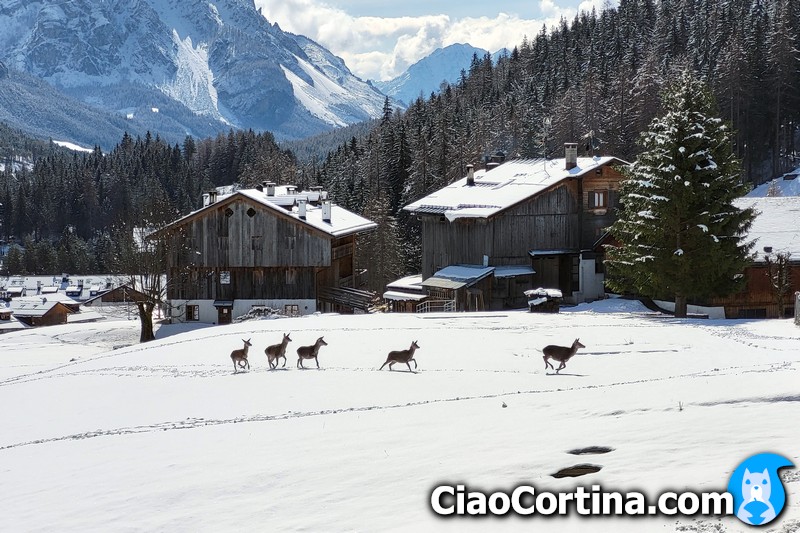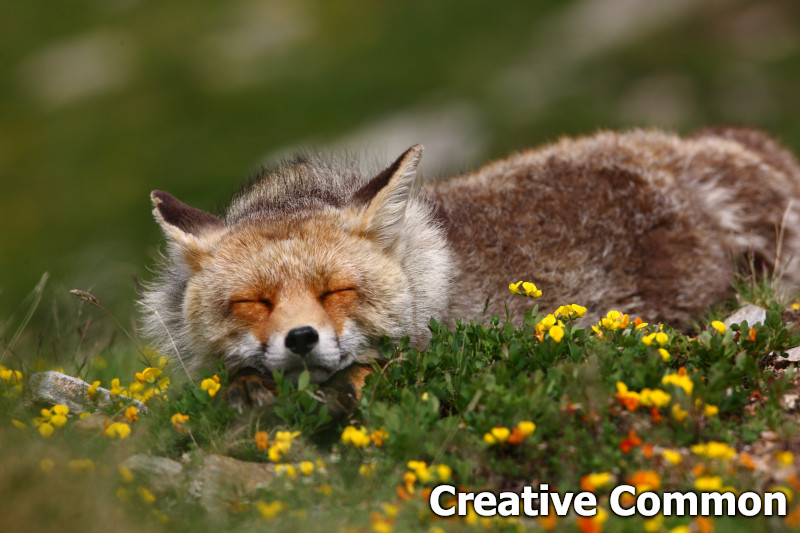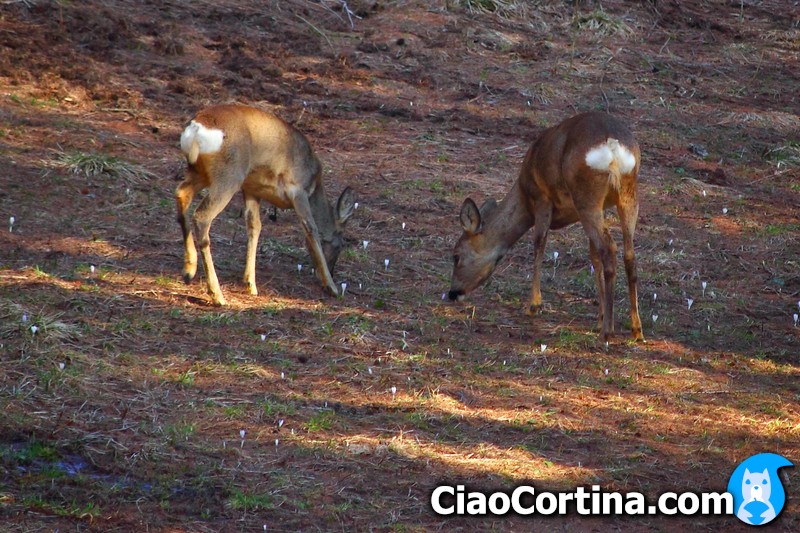Introduction
Cortina d'Ampezzo is a small town surrounded by nature. You may often see cute animals, from the small ones like the squirrel to the more majestic ones, such as the deer. On this page, we'll describe the animals you might encounter in Cortina. For those who want more details, simply click on the name to open the Wikipedia page dedicated to it.

Small Size Animals
Let's start with Cortina's most familiar creature, the red squirrel, an animal so common in the valley that it has become its mascot. The squirrel is a rather shy animal, so you will be able to see it mainly when it goes from one tree to another, with his lightness and elegance. However, as soon as he climbs the tree, he will try to hide from the view of curious observers.

Slightly larger than squirrels, but much more difficult to spot because of their tendency to live at night, we have the marten, and the weasel, both can be found in the Cortina area.
These animals are sometimes a bit of a nuisance, as they have a nasty habit of hiding in the engine compartment of cars. Usually the only sightings of these creatures are the presence of a few paw marks under the hood of the car, where they could also cause some damage to the engine.

Of the same family of the martens, we have the European badger. It usually lives in the Ampezzo area but, because of its nocturnal habits and tendency to be wary of noise, it is rather hard to spot. If you should see one, remember that it is not friendly at all.

Another animal that can occasionally be seen wandering among the houses in Cortina is the red fox, now almost completely accustomed to the presence of humans, in some cases it can even be approached without letting it escape. It is probably one of the most beautiful animals to observe, thanks to its innate elegance and the beauty of its coat.

The last animal in this category is the marmot, a cute furry mammal, famous for the whistle with which it communicates with its fellows. The one photographed on this page was at "Ra Stua," but it is possible to see them in almost all of the alpine territory, usually above two thousand meters.

Some of these creatures are very shy, while others have become used to the presence of humans. Think that some specimens of roe deer and fox have become almost domesticated, to the point that they wander quietly among the houses, sometimes even in the central pedestrian area of Corso Italia.
These animals are harder to see at peak season, with noises and people, but on quieter, cooler days, especially in the evening, it is not uncommon to make such encounters.
 Help us stay ad-free with a small offer.Donate now!
Help us stay ad-free with a small offer.Donate now!
Medium Size Animals
Moving to a larger size, one of the most frequent animals to be spotted in Cortina is the roe deer. These animals move in herds and when snow whitens the mountain tops, they come close to the village to find something to eat.
Precisely because of this habit, they sometimes cross the streets, risking being run over by cars. When driving in Cortina, always try to drive slowly, especially when crossing large grassy pastures, such as those in the locality of "Campo" or "Fiames."

Some animals are less easy to spot, as they are not made to live among people. These animals can only be found at high altitudes while hiking in the mountains. Among these creatures the most iconic is undoubtedly the chamois, a high mountain goat famous for its ability to climb very steep walls more naturally than he walks over pastures. If you have a good eye you may see some of them climbing in places that seem impossible.

 Help us stay ad-free with a small offer.Donate now!
Help us stay ad-free with a small offer.Donate now!
Big Size Animals
A big size animal is the deer, famous for the antler stage, which characterizes the male specimens. They also tend to cross roads, especially in winter when the sun has gone down, so drive slowly.

One of the lesser known characteristics of deer is the cry they emit when they are in heat, between late September and early October. It is a loud bramble that, if you are walking alone at night, could give you quite a scare, especially if you have never heard it.
In addition to wild animals, one of the most characteristic animals in the mountains are the cows. Often in summer it is possible to see them grazing in the areas of "Ra Stua," "Larieto," or "Malga Federa."

These are very quiet animals, used to being with people, who spend the day grazing grass and resting. If you want to approach them, always watch for any signs of nervousness, as they are still animals and may be in a bad mood that day.
 Help us stay ad-free with a small offer.Donate now!
Help us stay ad-free with a small offer.Donate now!
Other Species
The Dolomites are not home to only mammals; in addition to the animals we mentioned earlier, Cortina d'Ampezzo is home to several varieties of birds, including woodpeckers, ptarmigans, some specimens of birds of prey such as goshawks, some specimens of capercaillies, and, if you are really lucky, the golden eagle.

All these animals are relatively difficult to spot, even the most skilled photographers have to do hours of stalking in the huts to be able to immortalize them.
 Help us stay ad-free with a small offer.Donate now!
Help us stay ad-free with a small offer.Donate now!
Reptiles
Obviously the animals that live in Ampezzo are not all furry and cute, the valley is also the home of reptiles and amphibians. The most iconic of reptile representatives living in the mountains is undoubtedly the viper, a relatively small snake, whose bite, however, can be potentially lethal. It is a fairly wary creature, but if you happen to see something slithering along your path, we recommend that you keep some distance and let it pass.
Very often the viper is confused with the slow worm, a species of lizard that is completely harmless to humans. In any case, when in doubt, keep a safe distance.

On stone walls it's often possible to see some lizards that hide when they see someone coming by, there are also a lot of frogs that live near lakes and ponds.
The last animal we want to talk to you about is certainly the cutest of reptiles, it is the alpine newt, a nice salamander that lives near the water.
 Help us stay ad-free with a small offer.Donate now!
Help us stay ad-free with a small offer.Donate now!
The Natural Park of the Ampezzo Dolomites
To protect this immense heritage of biodiversity, way bigger than we described in this page, in 1990 the "Regole d'Ampezzo" acquired, by the Veneto Region, the management of the Natural Park of the Ampezzo Dolomites.
Inside the park, that is located in the north of Cortina, live approximately one hundred sixty species of animals, including more than thirty species of mammals, more than one hundred species of birds and sixteen species including amphibians, reptiles and fish.
In addition to animals, there are also many plants, with sixty-eight varieties of trees and shrubs, thirty-two species of ferns and more than one thousand species of flowers, as well as a wide range of insects: there are one hundred types of butterflies alone.

The area of the Natural Park of the Ampezzo Dolomites is crossed by many hikes, among the most beautiful we can list the one to "Malga Ra Stua," the ring of "Pian de Ra Spines" or a visit to the "Fanes" Waterfalls. If you like this topic, we have written a page which includes all the most beautiful hikes in the area, you can find it below:

If you want more information about the Park of the Dolomites, here is the official website. Here you can read in-depth pages on flora, fauna, regulations and administration.
 Help us stay ad-free with a small offer.Donate now!
Help us stay ad-free with a small offer.Donate now!
Tips for Seeing Them
Before we conclude, we would like to give you a few tips to try to increase your chances of encountering some animals during your walks in Cortina:
- When you go walking, try to remain quiet. Animals are timid and often a noise will scare them away before you can even see them.
- Don't get your hopes up; you could spend days in the woods without meeting any of them, and find a deer grazing in your front lawn the day after.
- Keep your eyes and ears open, often a small noise hides a pleasant encounter.
- Remember to look up too, if you see a bird that seems to be flying effortlessly, traveling in wide circles, it could be a buzzard or an eagle.
- Treat animals with respect and try not to get too close; they are often wild creatures that may react suddenly.
- If an animal shows no fear of you and behaves strangely, it may be carrying rabies. Do not approach it or let it approach you.
 Help us stay ad-free with a small offer.Donate now!
Help us stay ad-free with a small offer.Donate now!
Conclusion
We hope you liked this page on the native animals of Cortina. Before saying goodbye, we would suggest you read our home page, with all the articles we wrote about Cortina d'Ampezzo.
If you want to thank us, you can read the page Support Us. If you only want to suggest a change, propose something, or just say hello, in the section Contacts and Info, you'll find all the ways to reach us.

